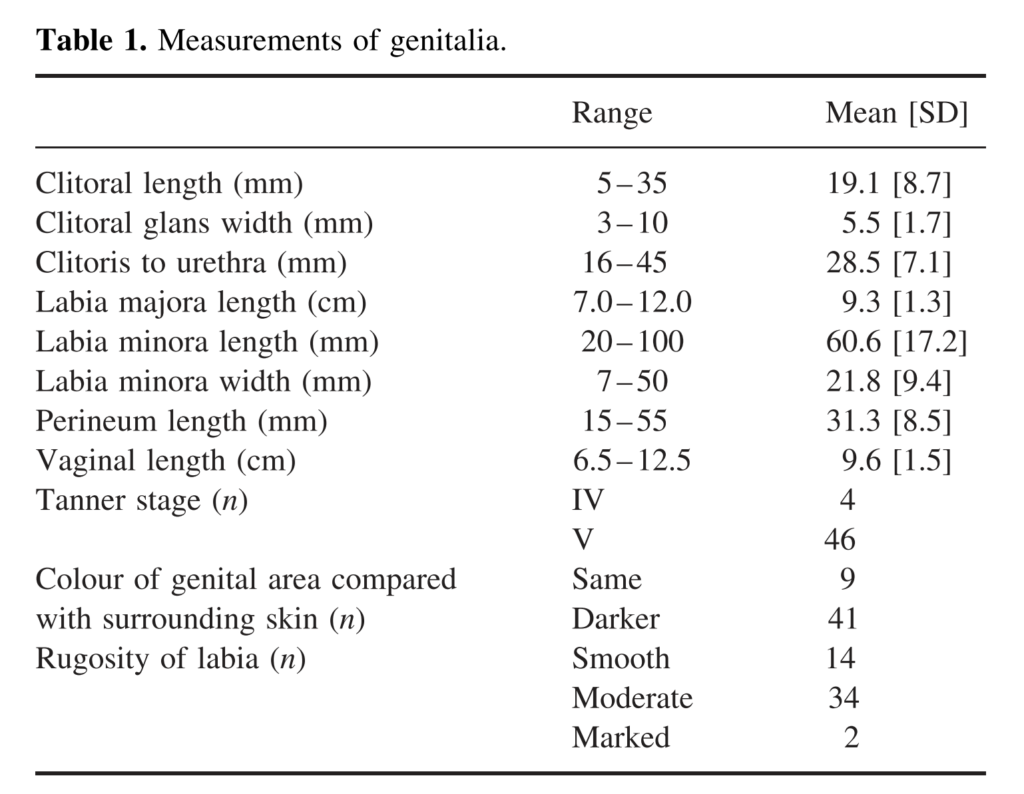
“Normal” vulvas – what science has to say
“But what IS normal?” you ask. Protruding inner labia? The Barbie doll slit? Luscious outer lips?
Let’s turn to science for an answer: to date, there are only four studies on natural anatomical variation of female genitalia in science literature – from Britain, Denmark, Turkey and Switzerland.
For the penis it’s different…
Interestingly, the penis has been measured up and down in erect and non-erect states in numerous studies. But there is not a single scientific study that has measured the vulva in an erect state! (If you know of a scientific study, please let me know, so I could add a reference here!)
What science has to say
The samples varied including pre- and postmenopausal women with sample sizes from 50 to 657 women – all from Europe. Thus we have to assume that all we really know is based on evidence relating to the natural variation of Caucasian women. The results proved quite similar, and I will give you the basic parameters:
In the Danish sample, 54% of the women had protruding labia minora (Wildfang Lykkebo et al., 2017). So it is just as normal to have protruding labia minora than not.
For the curious ones, here is a table from Lloyd’s British sample of 50 women on the normal range of clitoris and labia sizes (Lloyd et al., 2005; p. 644):

What the table tells you:
Labia majora are between 7 to 12 cm long (average 9.3 cm), the inner labia between 2 to 10 cm (average 6 cm).
The length of the outer part of the clitoris was between 0.5 to 3.5 cm long (average 1.9 cm).
The perineum was between 1.5 and 5.5 cm long (3.1 cm).
For five out of six women, the colour of the genital area was darker than the surrounding skin.
For two out of three women, the labia felt moderately rugose.
For more than 9 out of 10 women, pubic hair grew on the mons pubis and on the inner thighs (Tanner stage of pubic hair growth).
Take home message: variety and uniqueness
As you can see, variety is large. From this it is very difficult to ascertain what is “normal” or what is “not normal”. Virtually all sizes exist in the Caucasian samples – unfortunately, we do not yet have any scientific studies relating to women in other parts of the world.
“If we women knew more about our own bodies and the wide range of ‘normal’ when it comes to our genitalia, we would be less prone to outside voices telling us that we need to be fixed.” (Oeming, 2018; p. 84)
To fight the insecurity concerning female genitals not with a scalpel but with knowledge, learn about natural variation of vulvae!
Love your uniqueness!
References*
Basaran, M., Kosif, R., Bayar, U., & Civelek, B. (2008). Characteristics of external genitalia in pre- and postmenopausal women. Climacteric, 11, 416–421. https://doi.org/10.1080/13697130802366670
Kreklau, A., Vaz, I., Oehme, F., Strub, F., Brechbühl, R., Christmann, C., & Günthert, A. (2018). Measurements of a “normal vulva” in women aged 15-84: A cross-sectional prospective single centre study. BJOG: An International Journal of Obstetrics & Gynaecology. https://doi.org/10.1111/1471-0528.15387
Lloyd, J. J., Crouch, N. S., Minto, C. L., Liao, L. M., & Creighton, S. M. (2005). Female genital appearance: “Normality” unfolds. BJOG: An International Journal of Obstetrics and Gynaecology, 112, 643–646. https://doi.org/10.1111/j.1471-0528.2004.00517.x
Oeming, M. (2018). IN VULVA VANITAS – The rise of labiaplasty in the West. Gender Forum, 2, 70–91.
Wildfang Lykkebo, A., Drue, H. C., Lam, J. U. H., & Guldberg, R. (2017). The size of labia minora and perception of genital appearance: A cross-sectional study. Journal of Lower Genital Tract Disease, 21, 198–203. https://doi.org/10.1097/LGT.0000000000000308
*If you do not have access to these scientific articles but would like to read them, just let me know, I can send you a copy.